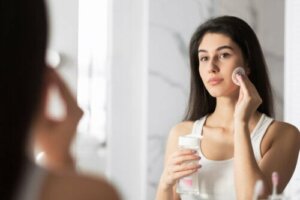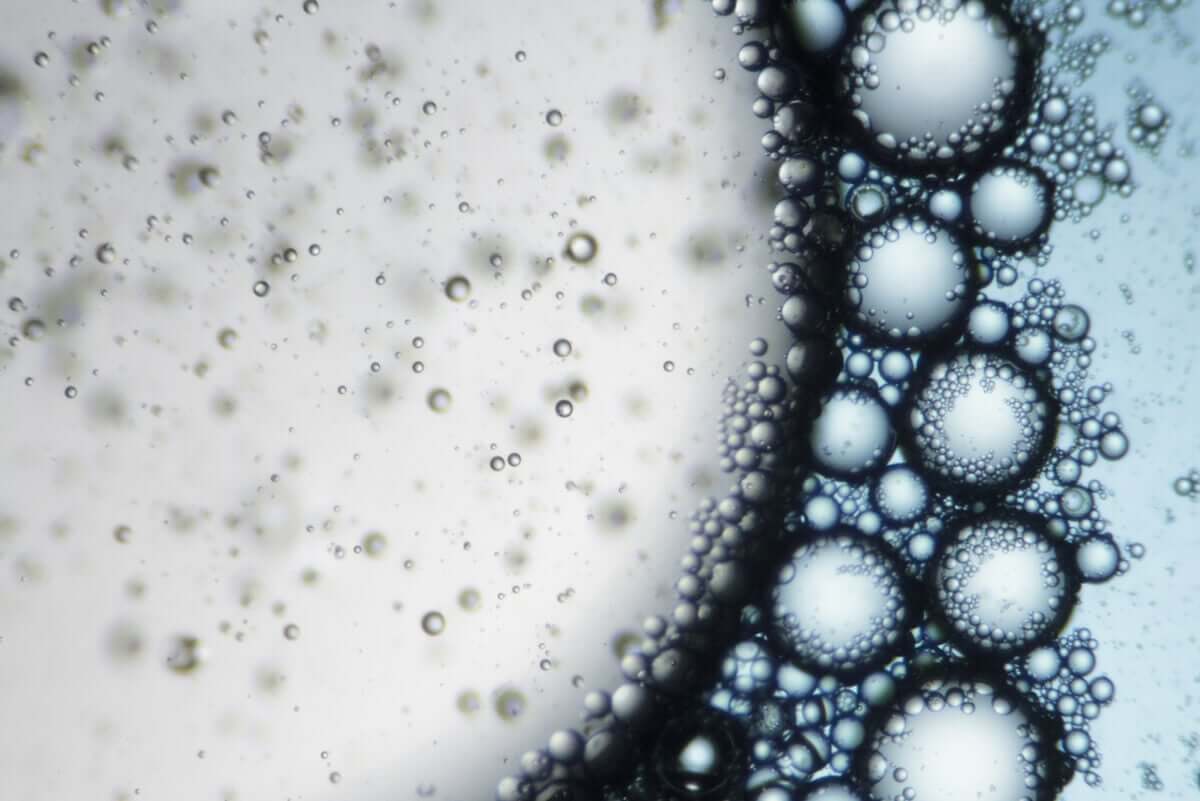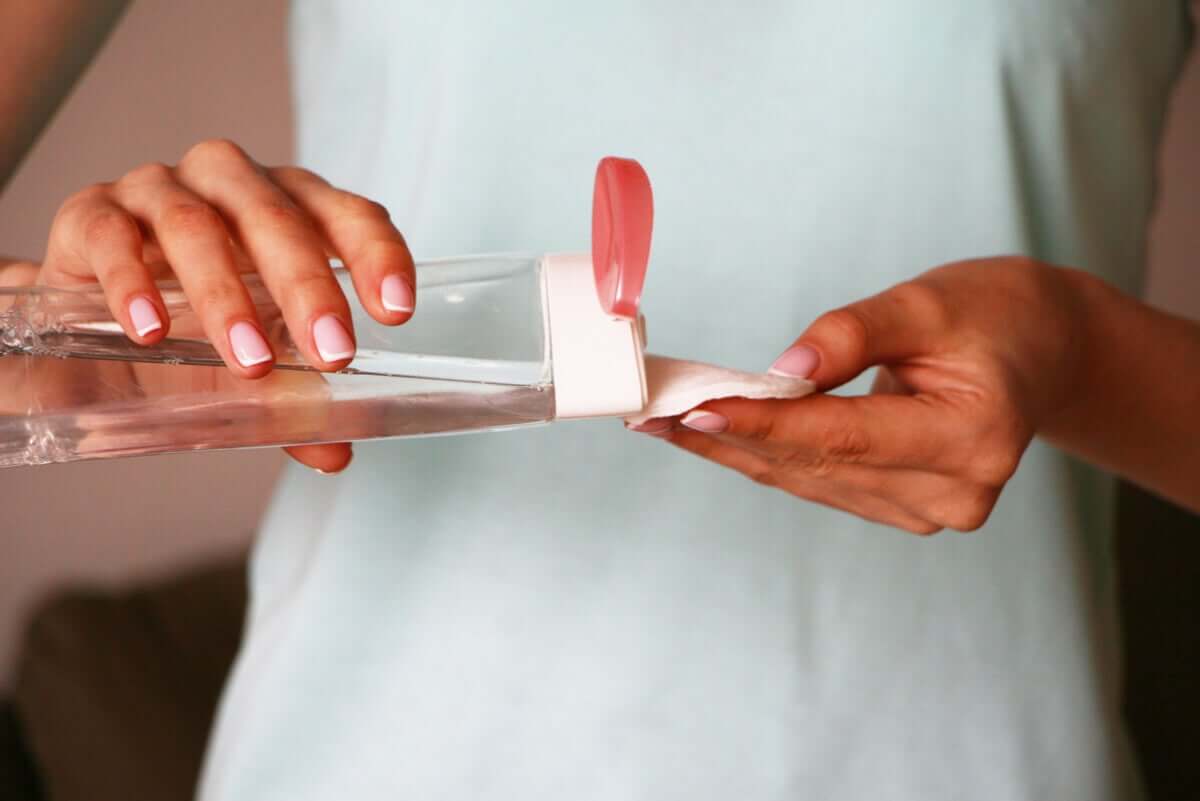What's Micellar Solution and What's It For?


Written and verified by the dermatologist Maria del Carmen Hernandez
Micellar solution has gained quite a bit of importance in skincare routines in recent times. Its use as a facial skin cleanser has increased, and it’s also a common ingredient in many skin products.
The success of this type of cosmetic is found in the efficient cleaning it generates. In addition, it leaves the skin soft and smooth which is always great! Keep reading to discover more details about micellar water.
What is micellar solution?
Micellar water, also called micellar solution, is one of the most popular products for facial care and cleansing. It’s considered a dermo-pharmaceutical, as it consists of a formula that you can buy in pharmacies and is intended for the skin.
Its formula includes mild surfactants that generate micelles. This is a chemical form that is based on the union of molecules through their water-repellent ends.
The micelles have the function of contributing to the contact between the surface of the skin and the dirt. Then, combined with water, water-soluble and liposoluble impurities are removed.
In addition to the surfactants, this type of product contains a variety of added components, such as moisturizers, astringents, or emollients. These substances give the micellar water other properties and this makes it one of the most complete cosmetics out there.

You might be interested in: Tips To Keep Your Makeup Bag Clean
What are its uses?
Micellar water not only leaves our skin soft, but is also very effective in removing dirt, make-up, and grease. In turn, it helps cleanse pores while toning the skin.
It’s an alcohol-free product and, according to publications in JAAD magazine, helps promote skin hydration while decreasing irritation and inflammation. This way, we can keep our skin soft, supple and smooth.
The cosmetic industry usually markets these cosmetics in relation to the type of skin in which they’ll be used on. There are micellar waters for the different variants of skin, which can be classified as normal or eudermic, dry or alipic, oily, aged, mixed, or dehydrated.
Needless to say, the essential step is to recognize one’s skin type in order to choose the right micellar water. In view of the confusion, it isn’t a bad idea to visit a dermatologist to learn about your dermal composition and find the perfect product for your skin.
How to use it in your daily routine
Proper hygiene and skincare is based on the application of different products to our skin in our everyday routine. Ideally, a cleansing routine should be carried out at least twice a day.
The first routine should be done first thing in the morning to cleanse the skin of the cells that were shed during the night and the oil generated during sleep. A nighttime routine at the end of the day is another good opportunity to implement this type of care in order to remove makeup and dirt that has accumulated over the course of the day.
Micellar water usually replaces all previous products in a skincare routine. In other words, it’s a substance capable of supplying cleaners, toners, and moisturizers. Therefore, it decreases the time you usually need for skincare to one easy, quick step.
There’s currently quite a lot of controversy as to whether micellar water should be rinsed off after use. It’s advisable to rinse your face after using it since cleansing agents can generate irritation when in contact with the skin, according to studies by Dermatologic Theraphy.
Also read: Skin Aging: Why Does it Happen?
5 benefits of daily use
Micellar water isn’t only useful for cleaning the face. It also has important benefits that help to protect our skin. When using it, we give our skin some of the following advantages:
- Hydration: The vast majority of micellar waters contain glycerin, which helps the skin to stay hydrated and not lose its water component. According to studies by Archives of Dermatological Research, glycerol has high hygroscopic power.
- Removes dirt and grease: The presence of micelles offers this property as it has the power to attract dirt particles.
- Effective for any type of skin: It has very low aggressive potential, which differentiates it from other types of cleaning soaps and lotions. In addition, there are variants for every skin need.
- Skin cleanser: It helps clean the pores and, as it’s a soft agent, it doesn’t cause any type of irritation with the presence of acne. In fact, a study by The Journal of Dermatology concludes that the combined use of a facial cleanser and moisturizers is safe and effective.
- Makeup remover: This product is very portable and easy to use. It’s effective as a makeup remover you can use at any time, even without running water.

The importance of micellar solution in our routine
Micellar water is one of the most complete products, taking into account its composition and properties. It offers benefits that make it valuable for those who use it, with few adverse effects and the benefit of reducing routines to fewer steps.
It’s one of the key ingredients in facial hygiene due to the wide range of options to choose from. The possibility of it being suitable for different and even opposite skins makes it a very attractive product and a must-have!
All cited sources were thoroughly reviewed by our team to ensure their quality, reliability, currency, and validity. The bibliography of this article was considered reliable and of academic or scientific accuracy.
- Atrux-Tallau N, Romagny C, Padois K, Denis A, Haftek M, Falson F, Pirot F, Maibach HI. Effects of glycerol on human skin damaged by acute sodium lauryl sulphate treatment. Arch Dermatol Res. 2010 Aug;302(6):435-41. doi: 10.1007/s00403-009-1021-z. Epub 2009 Dec 31. PMID: 20043170.
- Isoda K, Seki T, Inoue Y, Umeda K, Nishizaka T, Tanabe H, Takagi Y, Ishida K, Mizutani H. Efficacy of the combined use of a facial cleanser and moisturizers for the care of mild acne patients with sensitive skin. J Dermatol. 2015 Feb;42(2):181-8. doi: 10.1111/1346-8138.12720. Epub 2014 Dec 6. PMID: 25483138.
- Draelos Z, Hornby S, Walters RM, Appa Y. Hydrophobically modified polymers can minimize skin irritation potential caused by surfactant-based cleansers. J Cosmet Dermatol. 2013 Dec;12(4):314-21. doi: 10.1111/jocd.12061. PMID: 24305430; PMCID: PMC4285286.
- Cerezo, Beatriz Imedio. NUEVAS TENDENCIAS EN DERMOFARMACIA: EL AGUA MICELAR, ANÁLISIS DE COMPOSICIÓN Y CONSUMO. Diss. UNIVERSIDAD COMPLUTENSE, 2017.
- Ananthapadmanabhan KP, Moore DJ, Subramanyan K, Misra M, Meyer F. Cleansing without compromise: the impact of cleansers on the skin barrier and the technology of mild cleansing. Dermatol Ther. 2004;17 Suppl 1:16-25. doi: 10.1111/j.1396-0296.2004.04s1002.x. PMID: 14728695.
- Kuehl BL, Fyfe KS, Shear NH. Cutaneous cleansers. Skin Therapy Lett. 2003 Mar;8(3):1-4. PMID: 12858234.
This text is provided for informational purposes only and does not replace consultation with a professional. If in doubt, consult your specialist.








